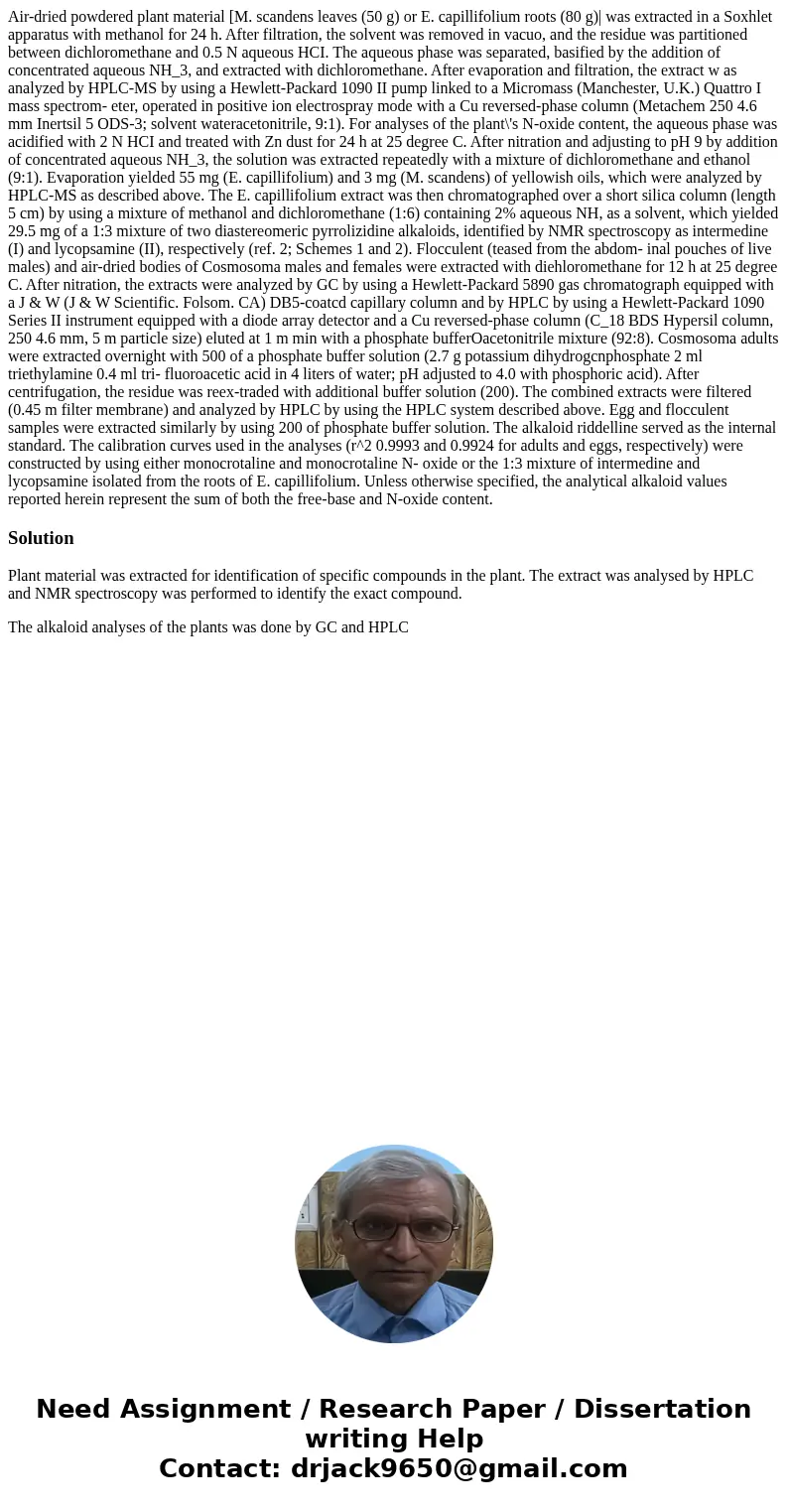Airdried powdered plant material M scandens leaves 50 g or E
Air-dried powdered plant material [M. scandens leaves (50 g) or E. capillifolium roots (80 g)| was extracted in a Soxhlet apparatus with methanol for 24 h. After filtration, the solvent was removed in vacuo, and the residue was partitioned between dichloromethane and 0.5 N aqueous HCI. The aqueous phase was separated, basified by the addition of concentrated aqueous NH_3, and extracted with dichloromethane. After evaporation and filtration, the extract w as analyzed by HPLC-MS by using a Hewlett-Packard 1090 II pump linked to a Micromass (Manchester, U.K.) Quattro I mass spectrom- eter, operated in positive ion electrospray mode with a Cu reversed-phase column (Metachem 250 4.6 mm Inertsil 5 ODS-3; solvent wateracetonitrile, 9:1). For analyses of the plant\'s N-oxide content, the aqueous phase was acidified with 2 N HCI and treated with Zn dust for 24 h at 25 degree C. After nitration and adjusting to pH 9 by addition of concentrated aqueous NH_3, the solution was extracted repeatedly with a mixture of dichloromethane and ethanol (9:1). Evaporation yielded 55 mg (E. capillifolium) and 3 mg (M. scandens) of yellowish oils, which were analyzed by HPLC-MS as described above. The E. capillifolium extract was then chromatographed over a short silica column (length 5 cm) by using a mixture of methanol and dichloromethane (1:6) containing 2% aqueous NH, as a solvent, which yielded 29.5 mg of a 1:3 mixture of two diastereomeric pyrrolizidine alkaloids, identified by NMR spectroscopy as intermedine (I) and lycopsamine (II), respectively (ref. 2; Schemes 1 and 2). Flocculent (teased from the abdom- inal pouches of live males) and air-dried bodies of Cosmosoma males and females were extracted with diehloromethane for 12 h at 25 degree C. After nitration, the extracts were analyzed by GC by using a Hewlett-Packard 5890 gas chromatograph equipped with a J & W (J & W Scientific. Folsom. CA) DB5-coatcd capillary column and by HPLC by using a Hewlett-Packard 1090 Series II instrument equipped with a diode array detector and a Cu reversed-phase column (C_18 BDS Hypersil column, 250 4.6 mm, 5 m particle size) eluted at 1 m min with a phosphate bufferOacetonitrile mixture (92:8). Cosmosoma adults were extracted overnight with 500 of a phosphate buffer solution (2.7 g potassium dihydrogcnphosphate 2 ml triethylamine 0.4 ml tri- fluoroacetic acid in 4 liters of water; pH adjusted to 4.0 with phosphoric acid). After centrifugation, the residue was reex-traded with additional buffer solution (200). The combined extracts were filtered (0.45 m filter membrane) and analyzed by HPLC by using the HPLC system described above. Egg and flocculent samples were extracted similarly by using 200 of phosphate buffer solution. The alkaloid riddelline served as the internal standard. The calibration curves used in the analyses (r^2 0.9993 and 0.9924 for adults and eggs, respectively) were constructed by using either monocrotaline and monocrotaline N- oxide or the 1:3 mixture of intermedine and lycopsamine isolated from the roots of E. capillifolium. Unless otherwise specified, the analytical alkaloid values reported herein represent the sum of both the free-base and N-oxide content.
Solution
Plant material was extracted for identification of specific compounds in the plant. The extract was analysed by HPLC and NMR spectroscopy was performed to identify the exact compound.
The alkaloid analyses of the plants was done by GC and HPLC

 Homework Sourse
Homework Sourse